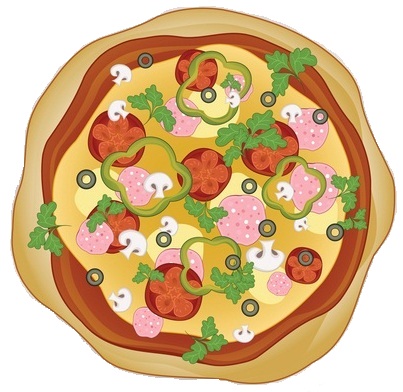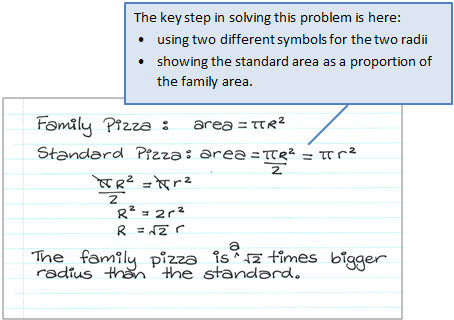The purpose of this activity is to engage students in using ratios to find a common ratio (scale factor).
This activity assumes the students have experience in the following areas:
- Finding areas of polygons and circles.
- Naming parts of circles, such as circumference, diameter, radius, arc length.
- Manipulating rational algebraic expressions.
- Applying ratios.
The problem is sufficiently open ended to allow the students freedom of choice in their approach. It may be scaffolded with guidance that leads to a solution, and/or the students might be given the opportunity to solve the problem independently.
The example responses at the end of the resource give an indication of the kind of response to expect from students who approach the problem in particular ways.

Task: A family sized pizza is baked in a pan that has twice the base area of a standard pizza pan.
Find how much bigger the radius of the family pizza pan is than the standard (ie find the scale factor for this enlargement).
The following prompts illustrate how this activity can be structured around the phases of the Mathematics Investigation Cycle.
Make sense
Introduce the problem. Allow students time to read it and discuss in pairs or small groups.
- What are the important words and symbols? (Students will need to interpret the meaning of base area and radius.)
- Can I imagine (visualise) what the pizzas look like?
- Where else in my life/the world can I see this happen? (Students may have encountered enlargement in other situations.)
- What will an answer to this problem look like? (It will provide a scale factor as a number)
Plan approach
Discuss ideas about how to solve the problem. Emphasise that, in the planning phase, you want students to say how they would solve the problem, not to actually solve it.
- What are the maths skills I need to work this out?
- What else do I need to know to get started?
- How could I show this problem using a diagram? (Can students sketch a hypothetical standard sized pizza and a family sized pizza with twice the area?)
- What rules will I need to solve this problem? (Students need to know or access the formula for area of a circle.)
- How many examples of circles should I try?
- How might algebra help me with this problem?
- What tools (digital or physical) could help my investigation?
Take action
Allow students time to work through their strategy and find a solution to the problem.
- Does my scale factor seem correct? Is it close to my estimation?
- Is there another possible way to solve the problem? Could I use algebra?
- Does the scale factor work for many examples (cases)?
- How do my results look different to others? Why could this be?
- How can I prove that my scale factor is correct?
Convince yourself and others
Allow students time to check their answers and then either have them pair share with other groups or ask for volunteers to share their solution with the class.
- Show and explain how you worked out your solution.
- Can others see how I worked it out?
- How does my solution answer the question?
- Would my answer work in a different situation? (Ideally students might generalise that a scale factor of √2 doubles the area of the original figure.)
- What scale factor would I use to triple the area? …to quadruple the area?
Examples of work
Work sample 1
The student finds a decimal scale factor, using concrete examples in their calculations.
Click on the image to enlarge it. Click again to close.
Work sample 2
The student finds an exact (surd) way to record the scale factor, using concrete examples in their calculations.
Click on the image to enlarge it. Click again to close.
Work sample 3
The student finds an exact (surd) way to record the scale factor, using algebraic generalisations.


